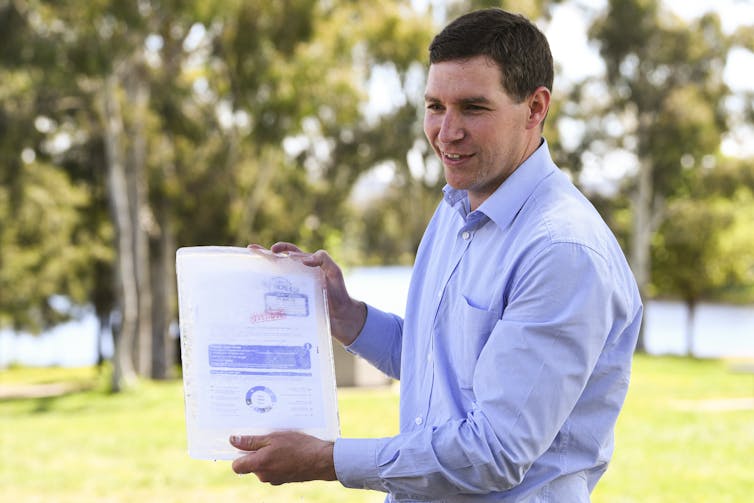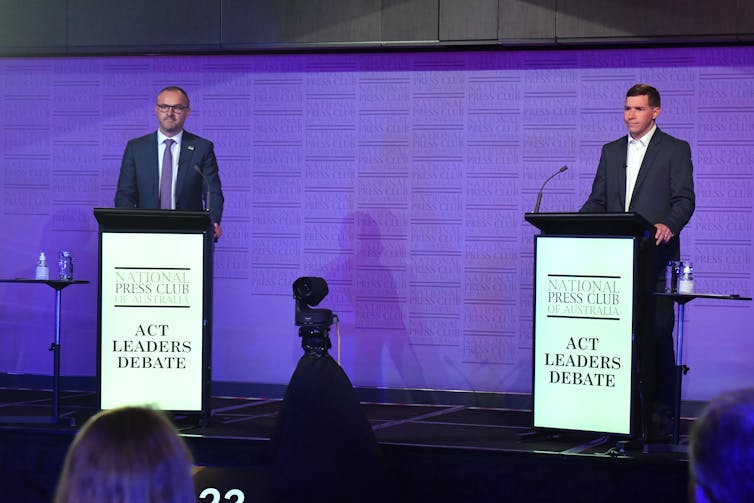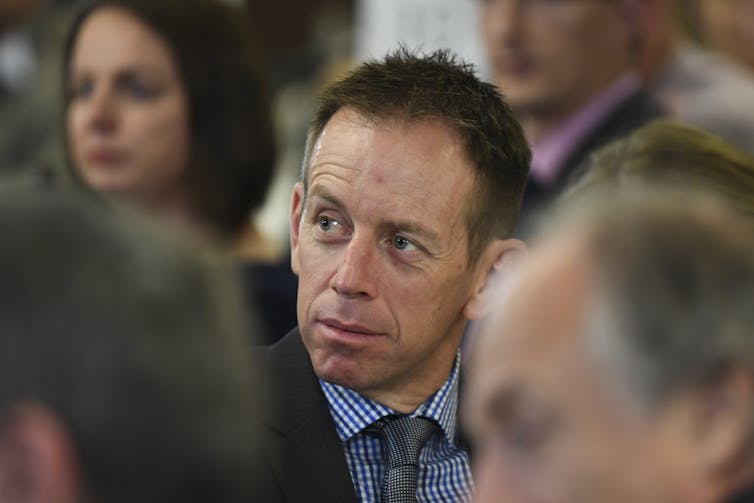Labor scores its sixth ACT election victory in a row. But the big winners are the Greens
- Written by John Warhurst, Emeritus Professor of Political Science, Australian National University
New Zealanders were not the only ones to go to the polls over the weekend. On Saturday, the Australian Capital Territory also voted, returning Labor for a sixth consecutive term after almost 20 years in office.
Andrew Barr, after almost six years as chief minister, has won a further four years in office.
The result confirms Canberra’s reputation as the most progressive jurisdiction in the Australia.
Big wins for the Greens, losses for Liberals
Labor’s vote remained steady, despite being the nation’s longest-serving government, albeit under different leaders.
The big winner on the night was Barr’s coalition partner, the Greens, led by Minister for Climate Change, Sustainability and Corrections, Shane Rattenbury.
The Greens earned a swing of 3.4%. It looks like the party will go from two to at least three seats, with the possibility of up to six in the 25-seat Legislative Assembly as counting is confirmed.
Read more: Labo(u)r easily wins in both New Zealand and the ACT, and leads in Queensland
There are five electorates of five members each under the ACT’s Hare-Clark electoral system and the Greens may have at least one member in each electorate.
The big loser was the Canberra Liberals, under new leader, 36-year-old Alistair Coe. They suffered an equivalent 3.4% swing against them and lost at least one and possibly three seats.
 Liberal leader Alistair Coe’s stunt-heavy campaign failed to resonate with voters.
Lukas Coch/AAP
Liberal leader Alistair Coe’s stunt-heavy campaign failed to resonate with voters.
Lukas Coch/AAP
With several seats still to be decided, at this stage, the outcome looks like it could be Labor 11, Liberals ten, and Greens four.
At the 2016 election Labor won 12 seats, the Liberals 11, and the Greens two.
A closer contest was expected
The return of the government was predictable, but the result was expected to be much closer.
Commentators predicted the Labor-Green coalition could lose a seat in the small assembly. Instead, they are set to increase their majority.
 ACT election watchers were expecting a closer result.
Mick Tsikas/AAP
ACT election watchers were expecting a closer result.
Mick Tsikas/AAP
The government ran as an experienced, progressive coalition, tagging the opposition leader as inexperienced and too socially conservative for Canberra. It was a low-key, steady pair of hands approach, in contrast to an opposition relying on stunts and expensive policy proposals.
It was the Greens, coming off a solid 2019 federal election performance, who painted a vision of a “better normal”, including action on climate change and social housing, rather than business as usual.
The Liberal’s slogan was “lower taxes, better services”, playing on community concerns about rate rises and problems in health and transport services. It wanted to “grow the pie” through population growth, by appealing for the return of Canberrans attracted to nearby NSW towns by lower property prices. It also painted the government as arrogant and tired.
But the Liberal campaign, widely acknowledged to be disciplined, failed to cut through and was dogged by its inability to convincingly answer where the money was coming from for better services, if rates were frozen. The Liberals have now campaigned for almost a decade against cost of living rises without any return.
Read more: Jacinda Ardern and Labour returned in a landslide — 5 experts on a historic New Zealand election
Saturday’s election result also sees the long-running controversy about the government’s investment in light rail resolved in Labor-Greens’ favour.
Despite concerns about the construction and usage of the new transport system, which launched in the city’s north in 2019, it is now seen as a positive. Canberrans in the southern suburbs want to get on board too.
Surprising results
Within the overall result, there were some intriguing variations between and within the parties and regions.
The Liberals’ lost a seat in its hitherto southern heartland, Brindabella. This may have been connected to growing concerns about climate change, fuelled by the bushfires and smoke haze at the beginning of the year.
But in the northern seat of Yerrabi, which benefited from the new light rail, Labor surprisingly looks like losing a seat to the Greens.
 It was a strong election for ACT Greens leader, Shane Rattenbury.
Lukas Coch/AAP
It was a strong election for ACT Greens leader, Shane Rattenbury.
Lukas Coch/AAP
Independents and new parties made no inroads. The Belco Party, created by former Liberal leader, Bill Stefaniak, fell short in the western seat of Ginnindera, damaging the Liberals in the process.
Stinging criticism of Labor, by former Labor Chief Minister Jon Stanhope, may have driven some Labor voters, not to the Liberals, but to the Greens.
Combined with retirements, the losses among sitting members on both sides may mean as many as seven new faces in the 25-member Legislative Assembly.
COVID elections good for incumbents
Given the small size of the ACT and its traditional Labor-leanings, there are few national lessons from Saturday’s result. But the Greens will be encouraged to campaign again on a positive vision.
Meanwhile, the idea that incumbent governments thrive under pandemic condition elections also received a boost. There will be another opportunity to test this theory when Queensland goes to the polls on October 31.
Read more: Remember Quexit? 5 reasons you should not take your eyes off the Queensland election
Authors: John Warhurst, Emeritus Professor of Political Science, Australian National University





